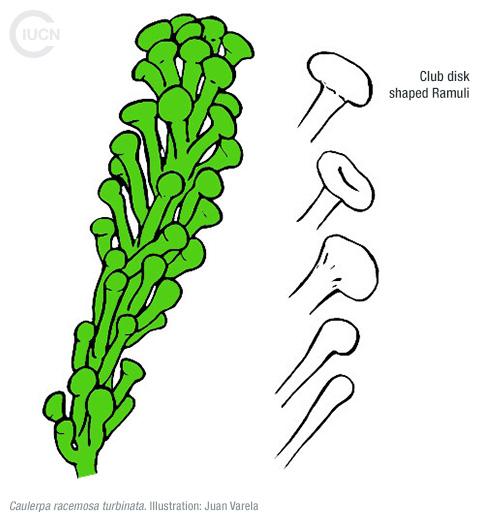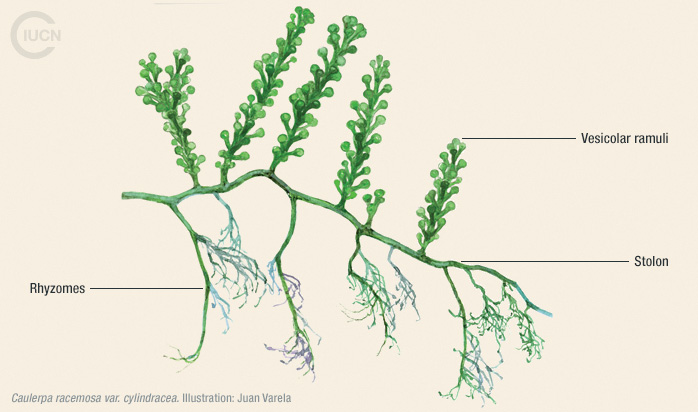Caulerpa cylindracea
Information
This alga occurs in different morphologies and sizes, especially frond length, depending on the region, depth and season. It can be found from the intertidal zone to depths of more than 60 m.
Caulerpa cylindracea is able to reproduce sexually and vegetatively. In sexual reproduction, the whole plant forms gametes, which are released simultaneously, resulting in the death of the parent plant.
Vegetative reproduction may occur in three ways, by growth, fragmentation or formation of propagules (ramuli dispersion). Fragmentation may occur in any part of the alga as a consequence of anthropogenic or natural causes, such as currents or grazing by animals. The plant is capable of rapid propagation from fragments.
Caulerpa cylindracea resembles the two native Caulerpa racemosa varieties. It is particularly similar to C. racemosa var. lamourouxii f. requienii, but in this native variety the surface is much smoother, the bladder-like ramuli are rounded but less inflated and shorter, and the erect fronds can be partly unbranched, slightly compressed or of irregular width. The other native variety, Caulerpa racemosa var. turbinata, has the ends of its branchlets flattened.


Caulerpa cylindracea is an endemic species from south-western Australia. The mode of introduction of the invasive Mediterranean variety of Caulerpa racemosa into the Mediterranean Sea remains speculative; however, maritime traffic (ballast water and ship hull fouling) and the aquarium trade are the most likely vectors for the introduction of this high-impact alga.
C. racemosa can still be found in aquarium stores and is sold by internet retailers.
Caulerpa cylindracea represents an important threat to the diversity of benthic coastal ecosystems (i.e. seagrass beds, maerl beds and coarse sediments), since it alters habitat characteristics, competes with native species and changes native benthic communities. This species is now found carpeting many coastal areas. It is considered to be one of the 100 worst invasive species in the Mediterranean, as it can alter the physical and chemical conditions of the environment (including water movement, sediment deposition and substrate characteristics), as well as causing profound changes to benthic assemblages of algae and invertebrates.
The economic impact of Caulerpa cylindracea has never been quantified, although there are reports of fishing nets being clogged and broken by this invasive alga, thereby reducing fish catches. The monotonous seascape produced by the dominance of this alga may also reduce the attractiveness of a site for underwater tourism (such as spearfishing, scuba diving and free diving).
Verlaque, M., et al. 2000. The Caulerpa racemosa complex (Caulerpales, Ulvophyceae) in the Mediterranean Sea. Botanica Marina 43, 49–68.
http://www.europe-aliens.org/pdf/Caulerpa_racemosa.pdf
Cebrian E., et al. 2011. Exploring the effects of invasive algae on the persistence of gorgonian populations. Biological Invasions DOI: 10.1007/s10530-012-0261-6.
Klein J, Verlaque M., 2008. The Caulerpa racemosa invasion: a critical review. Marine Pollution Bulletin 56, 205–225.







